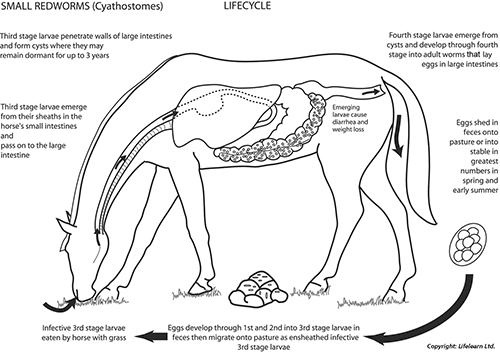Deworming in Horses
Parasitic worms live in the intestines of horses and ponies. Small numbers of worms can be tolerated, causing no effect on well-being. Larger worm burdens can cause a range of problems including ill thrift, diarrhea, colic and death. Pasture management and drug administration assist the horse’s immune system in keeping the intestinal population of worms under control. The immune response to worms is better in some horses and ponies than others and as such some are more susceptible to worm infestation.
What types of worms are there and what problems do they cause?
1. Small redworms (Cyathostomes): as the horse grazes it swallows the larvae of the small redworms, that can be found on blades of grass in contaminated pastures. The larvae colonize the lining of the large intestine where they develop into adults who lay eggs that are passed with the horse’s droppings onto the pasture and develop into larvae to complete the lifecycle. Larvae picked up in the autumn can go into hibernation in the intestine wall. These ‘encysted larvae’ can survive in this state for a considerable length of time, to develop into adult worms when the conditions become right for them, typically in the spring. It is the emergence from the bowel wall of large numbers of encysted larvae that can result in severe diarrhea. Other symptoms of cyathostomiasis include weight loss, lethargy and mild intermittent colic.

2. Large redworms (Strongyles) (such as Strongylus vulgaris , S. edentatus and S. equinus ): again, larvae are picked up and swallowed as the horse eats contaminated pasture. The lifecycle of these worms involves the migration of larvae through the blood vessels of the intestine and liver, where they can cause inflammation and obstruction of the blood vessels resulting in damage to the intestine supplied by the damaged vessel. Symptoms of infestation can include colic, ill thrift, and diarrhea.
